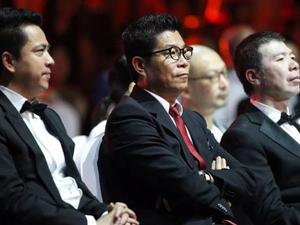Special topic: NVIDIA Q1 financial report comprehensively exceeded the expected official share splitting plan
Nvidia today announced its first fiscal quarter financial report of fiscal year 2025: revenue of US $26.044 billion, up 262% year on year and 18% month on month; Net profit was 14.881 billion US dollars, up 628% year on year and 21% month on month; Non GAAP's net profit was US $15.238 billion, up 462% year on year and 19% month on month (note: Nvidia's fiscal year was not synchronized with the natural year, and the period from the end of January 2024 to the end of January 2025 was 2025).
See: NVIDIA's revenue in the first fiscal quarter was $26.044 billion, and its adjusted net profit increased by 462% year on year
After the release of the financial report, Nvidia founder, president and CEO Huang Renxun, executive vice president and CFO Colette Kress and other executives attended the subsequent financial report conference call to interpret the key points of the financial report and answer analysts' questions.
The following is the main content of the question and answer session:
Stacy Rasgon, research analyst at Bernstein: I have a question about the Blackwell platform. The chip has been fully put into production, what does this mean for delivery and delivery time? What does it mean for customers?
Huang Renxun: We will ship after a period of production, but our production shipments will start in the second quarter and gradually increase in the third quarter. Customers' data centers should be able to use the Blackwell platform from the fourth quarter.
Stacy Rasgon: So Blackwell platform can start to contribute revenue this year?
Huang Renxun: This year we will see that the Blackwell platform contributes a lot of revenue to the company.
UBS Analyst Timothy Arcuri: I would like to ask Huang Renxun what are the differences in the company's deployment of the Blackwell platform. Considering the nature of its system and the huge market demand for performance, what is the difference between Blackwell deployment and Hopper platform deployment? I ask because large-scale liquid cooling has not yet been realized, and there are some engineering challenges at the node level and in the data center. Will these complex factors extend the transition time to Blackwell? How does management view the progress of all this?
Huang Renxun: Blackwell has multiple configurations. Blackwell is a platform, not a GPU. The platform supports air cooling, liquid cooling, X86 architecture, Grace processor, InfiniBand computer network communication standard, Spectrum X network platform and NVLink communication protocol, which I have shown at GTC (Nvidia Global AI Conference for Developers). Therefore, for some customers, they can upgrade the existing data centers that have deployed Hopper, and can easily transition from H100 to H200 and then to B100.
The Blackwell system is designed to be backward compatible in both electrical and mechanical aspects. Of course, the software stack running on Harper can also run well on Blackwell. We have also been pushing the entire ecosystem to be ready for liquid cooling. In the past, we have discussed Blackwell with ecosystem partners, including communication with CSP (cloud service provider), data center service provider, ODM (original design manufacturer), system manufacturer and supply chain, as well as communication with cooling supply chain, liquid cooling supply chain and data center supply chain. Everyone is prepared for the upcoming launch of Blackwell, and is full of expectations for the extraordinary performance that Grace Blackwell 2 can achieve.
Vivek Arya, analyst of Bank of America Merrill Lynch: How does the company ensure that NVIDIA products are used sufficiently in the market, rather than being snapped up or hoarded in advance due to tight supply, competition or other factors? What systematic factors can make investors believe that they can keep good profits under the condition of very large shipments?
Huang Renxun: Let me talk about the big picture first, and then answer your questions directly. The market's demand for GPUs and data centers is amazing. We are racing against time every day because of applications like ChatGPT and GPT 4.0, and the increasingly obvious trend of multimodality, including the growing Gemini, Anthropic and other AI big models. All CSP operations are consuming a huge amount of GPUs.
In addition, there are thousands of generative AI start-ups distributed in various fields from multimedia to digital characters, various design tools, productivity applications, digital biology, audiovisual industry to video migration, helping them train end-to-end models and expand the operation field of autonomous vehicles. The customer list is really long, which also puts a lot of pressure on us to deliver the system as soon as possible and make it run normally. Of course, what I mentioned earlier does not include all sovereign AI. They want to use their own natural resources, that is, data, to train their own regional models. They are also under great pressure to establish these systems. In short, the demand is very high and has exceeded our supply capacity.
In the longer term, we are completely redesigning the way computers work, which is a change of platform. Of course, we have seen many people compare this change with previous platform changes, but time will clearly prove that this change is much more profound than previous changes. The reason is that today's computer is no longer just an instruction driven device, but a device that understands intentions, not only the way we interact with it, but also what we ask it to do. It has the ability of reasoning and iterative reasoning, which is used to process plans and give solutions.
Therefore, the operation of computers in all aspects is changing, not only to retrieve pre recorded files, but also to instantly generate context sensitive intelligent answers, which will also change the computing stack around the world, and even the computing stack of personal computers will undergo revolutionary changes. This is just the beginning. Compared with our work in the laboratory and the results of our cooperation with start-ups, large companies and developers around the world, what people see today is only the tip of the iceberg, and the future applications will be extremely huge and extraordinary.
Morgan Stanley Analyst Joseph Moore: I understand the strong demand you just mentioned, the huge demand for H200 and Blackwell products. So when the sales of these products gradually increase, does the management expect the growth of Hopper and H100 product sales to pause? Will people slow down the sales of Hopper and H100 products because they are waiting for the release of new products, or do they think H100 has enough demand to maintain growth?
Huang Renxun: We see that the market demand for Hopper has been increasing in this quarter, and we expect that when the company turns to H200 and Blackwell, the demand for Hopper will exceed the supply for a period of time. All companies are eager to launch their infrastructure. These actions can help them reduce costs and improve profits, and they hope to do so as soon as possible.
Goldman Sachs Analyst Toshiya Hari: I have a question about competition that I want to ask the management. We see that many of the company's customers in the cloud industry have announced new internal projects or updated existing internal projects while cooperating with Nvidia. In the medium and long term, do companies think they are likely to become competitors? On this issue, the management believes that they will be limited to handling most internal workloads, or that the scope of processing may expand to a broader range in the future?
Huang Renxun: There are several differences between us and our customers. First, Nvidia's accelerated computing architecture helps customers develop backup products in all aspects, from unstructured data processing for training, to structured data processing, to SQL like data frame processing for training, to training reasoning. As I mentioned earlier, reasoning has fundamentally changed. Now it has reached the generation stage. It is not only cat face recognition - of course, this recognition itself is a very difficult task - but also must generate each pixel of the cat image. Therefore, the generation process is a fundamentally different processing architecture, This is one of the reasons why TensorRT is so popular.
Using the same chip, we have tripled the performance of our own architecture. This explains the richness of NVIDIA's architecture and software to some extent. NVIDIA architecture has a wide range of applications, from computer vision to image processing, from computer graphics to all computing modes. And because general computing has come to an end, the world is now suffering from the expansion of computing costs and computing energy. Accelerating computing is indeed a sustainable way of continuous progress. Through the application of accelerated computing, customers can save money and energy in computing. The multi-functional nature of Nvidia platform minimizes the operating costs of the data center.
Secondly, all cloud service providers are using Nvidia's products, so for those developers looking for a development platform, it is a good choice to start from Nvidia. We serve both local databases and cloud data centers. All kinds of computers and computing devices are using our products, so we are actually ubiquitous. The third reason is related to our construction of AI factories. Many people are increasingly aware that AI is not just a problem of chips.
Of course, chips with excellent performance are the basis for the development of AI. We have also made a series of chip products for our AI factories, but the development of this industry is more a system problem. AI is not just a large language model, but a complex system composed of a series of large language models that work together. By building this system, Nvidia can continuously optimize all our chip products, integrate them into a system for collaborative operation, develop software to ensure the smooth operation of the system, and continuously optimize the entire system.
Figures can be used to explain the situation very concisely. If there is an infrastructure worth 5 billion dollars, its value will increase by 5 billion dollars by doubling the efficiency of the infrastructure, but the investment in upgrading data center chips may not be so much, so the value of Nvidia products is indeed extraordinary, This is why performance is critical in today's business scale expansion. Achieving the highest infrastructure performance is actually the lowest in terms of cost input, because other aspects of operating infrastructure costs are very high, including investment in data centers, costs of operating data centers, related personnel, energy and real estate, etc. Therefore, improving performance is actually the lowest cost investment.
Matt Ramsay, TD Cowen analyst: I have always been a practitioner in the data center industry, but I have never seen a company like Nvidia launch a new platform so quickly and significantly improve its performance. For example, the performance in training has been improved by 5 times, and the performance in reasoning has even been improved by 30 times. This is really amazing. But at the same time, this also brings an interesting problem. Customers have spent billions of dollars on the current generation of products. However, compared with your new products, their competitiveness will decline quickly, and the decline speed is faster than the depreciation cycle of the products. So I would like to ask Huang Renxun to talk about how you view the development of this situation and what problems customers will encounter in this process?
Huang Renxun: Thank you very much for sharing. I would like to make three points. If you only have 5% (digital center) deployment, your experience will be very different from that of 95% (digital center) deployment, and those companies that have only had 5% deployment will certainly accelerate the deployment. The emergence of Blackwell platform, and as you mentioned, there will be other Blackwells in the future, as we said, The company will keep the pace of releasing a new product every year. Customers should also be willing to see the company's long-term development roadmap. In the future, there will certainly be more types of NVIDIA chips available to them. As long as they are willing to continue to invest in deployment, the average performance of their data center can continue to improve. These investments must also be wise. Gaining benefits and saving costs are their driving forces for continuous deployment.
In addition, the value of time is also very great. For example, rapid deployment of the data center and early start of data training mean great value, because only by taking the lead in developing higher level AI technology can we have the strength to launch the next groundbreaking AI product, and what followers can do may be just to improve slightly on the basis of the leader's products. So the question is, do you want to be a company that constantly launches pioneering AI products, or follow other companies to optimize their products. This is a competition. Like all technical competitions, the results are very important.
Many companies are participating in this competition. It is very important for the company to have technical leadership, which can make customers trust this leadership, be willing to deploy based on your platform, and clearly understand the long-term development strategy of your platform. It is also important to start data training as early as possible, Starting the training three months in advance may mean winning the technical competition, which is why we are crazy about deploying the Hopper system, because we believe that the next climax of technical progress is coming.
What you mentioned is very good. It is how we can release new products so quickly and achieve rapid technological progress. Because we have a rich type of stack, Nvidia has participated in the whole process of the deployment of the entire data center. We have achieved global monitoring, global measurement and optimization for all data operation problems. Through these practices, we can understand where the various bottlenecks hindering the operation are, instead of relying on guesswork and making slides that look big - of course, we also hope to make slides that look big - but what we deliver to customers is a system that operates on a large scale, and its effective large-scale operation must rely on Nvidia's platform.
This may sound a bit magical. We first built a whole set of AI infrastructure ourselves, then decomposed it, and integrated each part into their data center according to the customer's needs. We know what bottlenecks may appear in the operation process, and we know how to cooperate with customers to optimize the infrastructure, How to help customers get the best infrastructure performance. Nvidia stands out in the industry with its profound knowledge of data center deployment on such a scale. Each chip of the company is from scratch. We know exactly how the whole system is processed and how to get the maximum benefit from each generation of products.
Mark Lipacis, analyst at Evercore ISI: Huang Renxun has mentioned before that the general computing ecosystem usually occupies a dominant position in all computing times. I guess this conclusion is based on the fact that general computing can adapt to different workloads, thus achieving higher utilization and reducing the cost of computing cycle. This may also be a motivation for Nvidia to establish CUDA general parallel computing architecture and promote the implementation of GPU accelerated computing ecosystem. If I say something wrong, please correct me.
So my problem is that, since the needs of NVIDIA solutions are mainly driven by the work of neural network training and reasoning, it seems that these needs are relatively limited on the surface. I know that these solutions may also meet some customized needs. I want to know whether there are risks in the market demand of the general computing framework? Or does the company need to look for other workloads to support the market demand for this framework?
Huang Renxun: Yes, NVIDIA's accelerated computing is widely used, but I wouldn't call it universal computing. For example, we are not so good at running spreadsheets, which is really designed for general computing. The control loop of operating system code may not be suitable for accelerating computing. Therefore, I would say that our accelerated computing is multi-purpose. Over the years, Nvidia accelerated computing has a lot in common in many fields, but also has some profound differences - both can run in parallel, and have a large number of threads. For example, 5% of the code accounts for 99% of the running time. These are the characteristics of accelerated computing.
In the past 10 years or so, a large number of start-ups have emerged, which has promoted the development of Nvidia's platform versatility and prompted us to design the entire system. The architecture of these start-ups is usually relatively small, so Nvidia products are needed to help them achieve compatibility with various new technologies, including generative AI, fusion models, or the next model. For example, in the face of large language models with memory and the need to understand morning and afternoon, the versatility of the Grace processor becomes super important. Every progress in generative AI technology is a push for Nvidia products to achieve a wider range of uses, to enable us to meet the needs of the whole field with one product, and to promote the continuous improvement of software.
We believe that the scope of application of these models will continue to expand, and their usage will increase by one million times in the next few years. We are full of expectations for this, and we are ready for it. The multi-functional features of Nvidia's platform are the key to achieving these extensions. However, if your system is too low in scalability, or the requirements are too specific, we recommend deploying FPGA microprocessors or ASICs (application specific integrated circuits), but that is not strictly a computer.
Blayne Curtis, Jeffery analyst: The company has launched H20 chip for the Chinese market. How does the management view the prospect of this product? I thought there would be great market demand, but obviously, we are also trying to meet the customer demand of other Hopper products. What are the management's prospects for the company's sales and gross profit margin in the second half of this year? What impact may be caused by insufficient demand for H20 products?
Huang Renxun: We respect every customer and will try our best to provide service for every customer. We will continue to try our best to provide services to customers there, and do our best. In general, the situation that supply falls short of demand I mentioned earlier is specific to the overall market situation, especially for products such as H200 and Blackwell, It is expected that this situation will last until the end of the year 。
Srini Pajjuri, Raymond James analyst: As for what has just been mentioned, could you ask Huang Renxun to clarify a few points. The market demand for GB200 system seems to be very large. Looking back, we sold many HGX mainboards and a certain number of GPUs, while the system business is relatively small. So I'm curious, why is the current demand for the system so great? Is it just because of the cost, or is there another reason, or is it because of the architectural requirements?
Huang Renxun: The way we sell the GB200 (the same as the way we sell the infrastructure) is the same - decompose all components and integrate them organically into the computer manufacturer's system. This year, there will be 100 different computer system configurations for Blackwell, a very amazing combination.
Frankly speaking, the number of Hopper's computer system configurations is only half of Blackwell's, but that is the peak of Hopper's implementation. At the beginning, the number was much smaller. So investors can see the liquid cooled version, air-cooled version, X86 version, Grace version, etc. There are a large number of configuration systems being designed and will be provided through the ecosystem of NVIDIA's high-quality partners.
The Blackwell platform has greatly expanded our product range. CPU integration, more compact computing density, and liquid cooling technology will save a lot of money for the data center in terms of power supply and improve energy efficiency. All parties involved in the cooperation can benefit from it - we have provided more components for the data center, greatly improved the performance of the data center, and realized more efficient network connection. Of course, there are also customers who use the NVIDIA AI AI platform to serve the ecosystem only deployed in Ethernet through the network card and Ethernet. Blackwell's service scope will continue to expand.
William Stein, Truist analyst: I have a question for Huang Renxun. Although there are some fairly good CPU products in the market that can be used to support the operation of data centers, NVIDIA's Grace CPU based on ARM architecture has greater advantages, which may be related to cost, power consumption or technical synergy between Grace/Hopper and Grace/Blackwell. Will similar situations occur on the client side? There are already very good solutions in the market, and Nvidia also stressed that Intel and AMD And jointly released excellent X86 based products. With the emergence of AI workload, is it possible for Nvidia to launch superior products that other suppliers are more difficult to provide in this field?
Huang Renxun: You have explained this problem very well. Indeed, for many applications, our cooperation with related companies in X86 is very good. We have built excellent systems together, but Grace can let us do something that is impossible under the current system configuration. The memory systems of Grace and Hopper are consistent and interconnected. The interconnection of these two chips, in fact, is a bit strange to call them two chips, because together they are like a super chip, which can transmit terabytes per second (TB) through the interface, which is amazing. Grace uses LPDDR memory, a data center level low-power memory, so we save a lot of power on each node.
Finally, because we can now use this system to create our own architecture, and it is an architecture with a large NVLink domain, which is crucial for the reasoning of the next generation of large language models. So you can see that the GB200 system has 72 node NVLink domains, just like 72 Blackwells connected together to form a huge GPU. We need Grace/Blackwell to do this. Therefore, we say that there are architectural reasons, software programming reasons, and system reasons, which are essential for us to build architecture in this way. If we see such opportunities, we will explore them. You may also pay attention to yesterday's Microsoft The content of the Build launch conference was very excellent. Satya (Microsoft CEO) announced the next generation of personal computers, focusing on the functions of Copilot+personal computers. Nvidia's RTX GPU was used in notebook products, which performed very well. At the same time, it also well supported the ARM architecture, opening up opportunities for personal computer system innovation.
Cantor Fitzgerald analyst C J. Muse: I would like to ask Huang Renxun about the long-term development of a company. Blackwell has not been officially released yet, but investors are forward-looking. With the increasingly fierce competition between GPU and customized ASIC, Nvidia has released CUDA, Precision, Grace and other products in the past decade. What do you think of the amazing million fold growth of the company during this period? Looking ahead, what problems should the company solve in the next decade? Do you have more information to share with investors today?
Huang Renxun: I can announce that after Blackwell, we will have another new chip product , we will maintain the rhythm of one new product every year. You can also look forward to our new breakthrough in network technology. We will launch Spectrum X network platform to serve Ethernet customers, and we will fully invest in Ethernet. Our development plan in the Ethernet field is very exciting. We have a rich and complete ecosystem of partners, Dell Spectrum-X has been announced to be launched to the market, and many customers and partners will release products adopting NVIDIA AI factory architecture.
For those companies pursuing the ultimate performance, our InfiniBand architecture is the best choice. InfiniBand is a computing architecture, Ethernet is a network, and InfiniBand was initially introduced to the market as a computing architecture, but gradually developed into a better and better network. Ethernet is a kind of network, and with the help of Spectra-X, Ethernet has become a better computing architecture. We will devote ourselves to promoting the development of NVLink computing architecture, InfiniBand computing architecture and Ethernet network computing architecture at a very fast speed.
So you will see Nvidia's new switches, new network cards, new production capacity, and the new software stack running on these three. There are also new CPU products, new GPU products, new chip products, etc. These new products will be able to run CUDA and all Nvidia software stacks. After customers invest in Nvidia software stack, their products will run faster and faster without any other operation. After investing in NVIDIA architecture products, customers can access more cloud platforms and data centers without any other operations, and everything will run smoothly. Our ultra fast innovation speed, on the one hand, will increase production capacity, on the other hand, can reduce costs. The expansion of Nvidia architecture in the new computing era will usher in a new industrial revolution, In this industrial revolution, we will not only produce software, but also produce AI tokens on a large scale. (End)
When the stock market recovers, open an account first! Intelligent fixed investment, condition sheet, individual stock radar... for you>>

Massive information, accurate interpretation, all in Sina Finance APP
Editor in charge: Liu Mingliang












